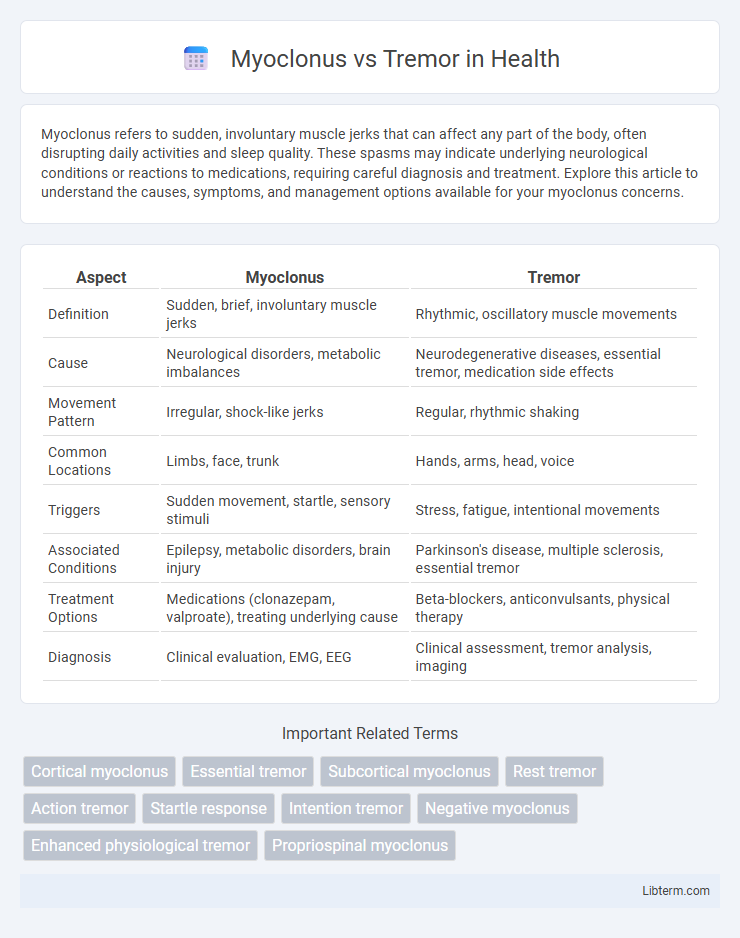Myoclonus refers to sudden, involuntary muscle jerks that can affect any part of the body, often disrupting daily activities and sleep quality. These spasms may indicate underlying neurological conditions or reactions to medications, requiring careful diagnosis and treatment. Explore this article to understand the causes, symptoms, and management options available for your myoclonus concerns.
Table of Comparison
| Aspect | Myoclonus | Tremor |
|---|---|---|
| Definition | Sudden, brief, involuntary muscle jerks | Rhythmic, oscillatory muscle movements |
| Cause | Neurological disorders, metabolic imbalances | Neurodegenerative diseases, essential tremor, medication side effects |
| Movement Pattern | Irregular, shock-like jerks | Regular, rhythmic shaking |
| Common Locations | Limbs, face, trunk | Hands, arms, head, voice |
| Triggers | Sudden movement, startle, sensory stimuli | Stress, fatigue, intentional movements |
| Associated Conditions | Epilepsy, metabolic disorders, brain injury | Parkinson's disease, multiple sclerosis, essential tremor |
| Treatment Options | Medications (clonazepam, valproate), treating underlying cause | Beta-blockers, anticonvulsants, physical therapy |
| Diagnosis | Clinical evaluation, EMG, EEG | Clinical assessment, tremor analysis, imaging |
Understanding Myoclonus: Definition and Causes
Myoclonus refers to sudden, involuntary muscle jerks caused by rapid contractions or relaxations of muscle groups, often linked to neurological conditions such as epilepsy, metabolic disorders, or brain injury. This movement disorder differs from tremor, which involves rhythmic, oscillatory muscle activity usually associated with Parkinson's disease or essential tremor. Understanding the underlying causes of myoclonus, including genetic factors, medication side effects, or neurodegenerative diseases, is crucial for accurate diagnosis and targeted treatment strategies.
What Is Tremor? Types and Triggers
Tremor is an involuntary, rhythmic shaking movement affecting parts of the body, commonly the hands, head, or voice. Types of tremor include essential tremor, which is often hereditary and worsens with movement; Parkinsonian tremor, typically occurring at rest and linked to Parkinson's disease; and intention tremor, seen during purposeful movements and associated with cerebellar dysfunction. Common triggers of tremors consist of stress, fatigue, caffeine, certain medications, and neurological disorders, influencing the severity and frequency of shaking episodes.
Key Differences Between Myoclonus and Tremor
Myoclonus involves sudden, brief, involuntary muscle jerks caused by abnormal neural discharges, often linked to conditions like epilepsy or metabolic disorders. Tremor is characterized by rhythmic, oscillatory movements caused by alternating muscle contractions, frequently associated with Parkinson's disease or essential tremor. While myoclonus is irregular and shock-like, tremor presents as a consistent, repetitive motion.
Clinical Symptoms: How Myoclonus Manifests
Myoclonus manifests as sudden, brief, involuntary muscle jerks that can affect various muscle groups, often occurring unpredictably or in response to stimuli such as light, noise, or movement. These jerks differ from tremors, which are rhythmic, oscillatory movements primarily seen during rest or action. Clinical symptoms of myoclonus include shock-like contractions that may interfere with voluntary movements, sometimes accompanied by underlying neurological disorders like epilepsy or metabolic imbalances.
Recognizing Tremor: Common Presentations
Tremor commonly presents as rhythmic, involuntary shaking most noticeable in the hands, arms, or head during rest or intentional movement. Unlike myoclonus, which involves sudden, brief muscle jerks, tremors are typically continuous and can worsen with stress or fatigue. Essential tremor and Parkinsonian tremor are frequent clinical types, helping differentiate tremor patterns during diagnosis.
Diagnostic Tools for Myoclonus vs Tremor
Electromyography (EMG) and electroencephalography (EEG) play critical roles in differentiating myoclonus from tremor by analyzing muscle activity patterns and neural origins. Video-polymyography captures the characteristic brief, shock-like jerks of myoclonus, while tremors exhibit rhythmic oscillations on accelerometry and EMG tracing. Functional neuroimaging and response to pharmacological testing further aid in distinguishing the distinct pathophysiology of myoclonus and tremor.
Underlying Neurological Disorders Linked to Myoclonus
Myoclonus is frequently associated with underlying neurological disorders such as epilepsy, Parkinson's disease, and multiple sclerosis, characterized by sudden, involuntary muscle jerks. Unlike tremor, which is rhythmic and often linked to cerebellar or basal ganglia dysfunction, myoclonus involves rapid, shock-like muscle contractions rooted in abnormal electrical activity within the cerebral cortex or spinal cord. Identifying the specific neurological cause of myoclonus is essential for targeted treatment, highlighting conditions like progressive myoclonic epilepsy or metabolic encephalopathies.
Conditions Commonly Associated with Tremor
Tremors are commonly associated with neurological conditions such as Parkinson's disease, essential tremor, multiple sclerosis, and cerebellar disorders. These conditions often manifest with involuntary, rhythmic shaking primarily affecting the hands, head, or voice. Unlike myoclonus, which involves sudden, brief muscle jerks, tremors typically present as sustained oscillatory movements linked to underlying motor control dysfunctions.
Treatment Approaches for Myoclonus and Tremor
Treatment approaches for myoclonus often include medications such as clonazepam, valproic acid, and levetiracetam to reduce sudden muscle jerks, while addressing underlying causes is essential. Tremor management typically involves beta-blockers like propranolol, anticonvulsants such as primidone, and in severe cases, deep brain stimulation (DBS) targeting the thalamus. Physical therapy and lifestyle modifications may complement pharmacological interventions for both movement disorders, enhancing functional outcomes.
Prognosis and Quality of Life Considerations
Myoclonus, characterized by sudden, involuntary muscle jerks, often varies in prognosis depending on its underlying cause, with some forms associated with neurodegenerative diseases leading to progressive decline. Tremor, typically presenting as rhythmic shaking, may be benign or linked to conditions like Parkinson's disease, affecting motor control and daily activities over time. Quality of life in both disorders hinges on symptom management, with tailored treatments such as medications, physical therapy, or deep brain stimulation improving functional ability and reducing disability.
Myoclonus Infographic

 libterm.com
libterm.com